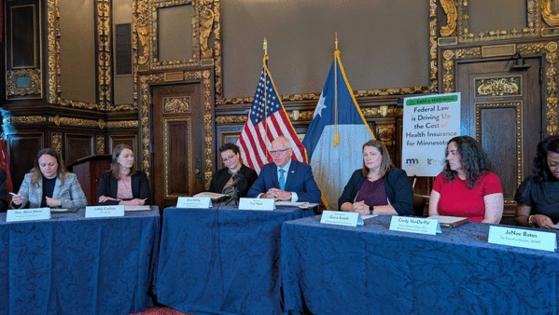Walz calls out Trump for rising health insurance costs
Published in News & Features
Minnesotans who buy their own health insurance will pay more out of pocket next year because of double-digit premium increases, and Gov. Tim Walz is blaming his political foes for their plight.
The governor, a Democrat running for reelection, faulted President Donald Trump and the Republican-controlled Congress on Tuesday for allowing some federal tax credits to expire next year that would have kept health plans on the individual market more affordable.
Some cost increases could be dramatic. For instance, a Mankato couple in their early 60s with income of $89,000 would not qualify for tax credits without Congressional action. Their premiums would rise from under $500 to nearly $2,000 per month, state officials estimated.
“Nationally, insurance rates are going to be as high as they’ve been in 15 years, and we’re seeing that be true in Minnesota,” Walz said.
The Washington, D.C.-based Paragon Health Institute has called for letting the enhanced tax credits expire. The health policy group said they were meant to provide temporary relief, and otherwise will balloon deficit spending by the government while inflating health care prices.
“Congress has better options to broaden choice and improve affordability,” Paragon Health Institute said in a report this month. The group called the subsidies “COVID credits,” and said the funding has “led to an explosion in fraudulent spending.”
Health insurers have filed proposed 2026 premiums for coverage sold via MNsure, the state’s health insurance exchange. So far the largest insurance providers have proposed price increases of 12% to 26%, according to the Minnesota Department of Commerce. The state is expected next week to approve final rates.
The governor gathered two state DFL lawmakers, cabinet members and some affected Minnesotans for a press conference at the Capitol to urge Congress to extend the tax credits next year. These so-called “enhanced credits” have been supplementing subsidies available to individuals who buy coverage under the federal Affordable Care Act (ACA).
Those “individual market” health plans cover about 186,000 Minnesotans, including farmers and workers at small businesses that don’t offer health coverage.
About 90,000 of them will lose some support for their monthly premiums and see costs rise if the enhanced tax credits go away, according to MNsure. That includes about 19,000 people who will lose all financial assistance.
Premiums would have been even higher next year if a bipartisan group of state lawmakers had not strengthened a mechanism called “reinsurance” to financially protect the insurance market, said Grace Arnold, state commerce commissioner.
However, Arnold said, “Minnesota shouldn’t have to cover for a broken federal government,” and reinsurance won’t prevent premium increases that force some Minnesotans to “choose between paying for health insurance or covering essentials like groceries, rent or child care.”
Minnesota farmer Cindy VanDerPol said she went uninsured last year and saved money to afford medications and checkups following her breast cancer treatments. Her family afforded subsidized health insurance this year, but she said they hoped not to use it, considering its high deductible.
“We’re still praying I don’t get sick again,” said VanDerPol, who owns the Pastures A Plenty farm in Kerkhoven, Minn. “It’s a huge source of stress, and I know I’m not alone in this.”
State leaders said they fear Minnesota is headed toward a tipping point that will undo some of the gains in insurance coverage achieved after the ACA became federal law.
As fast-rising premiums convince more healthy people to drop coverage, that could drive prices even higher in the individual market because insurers will be left to cover a greater concentration of people with costly health needs who can’t afford to go uninsured.
“Insurance companies are already pricing in uncertainty ... and making assumptions that those who remain in the market will be older and sicker,” Arnold said.
Meanwhile some young, healthy people will lose on their gamble to go uninsured, said JaNae Bates, a minister and co-director of ISAIAH, a multi-faith group that advocates for racial and economic equity. A furniture builder in Northfield, Minn., recently paid out of pocket for a $25,000 knee surgery because he was uninsured, she said.
Tax credits on premiums are available to individuals and families with incomes below 400% of the federal poverty standard, a threshold that works out to about $62,600 for a one-person household and $128,600 for a family of four.
Emergency legislation during the COVID-19 pandemic expanded eligibility to tax credits to people with incomes above 400% of poverty; it also increased the value of tax credits for people below the threshold. These are the enhanced tax credits set to expire at the end of the year unless Congress intervenes.
The average monthly premium increase would be $177 for those losing financial support, MNsure estimated, but would vary depending on whether people have household incomes above or below 400% of the federal poverty threshold.
Cost increases will hit Minnesotans hard, said Erika Helvick Anderson, MNsure’s senior director of public affairs, during a news conference last week.
While the senior couple in Mankato could see monthly premiums quadruple, younger people could face higher costs as well. A family of three in Ramsey County making $112,000 per year would lose access to tax credits, boosting their monthly premium by about $170 per month.
Without the enhanced subsidies, families just above 400% of federal poverty who buy their own insurance will face what is “an insurmountable fiscal cliff for a lot of people‚” said Lucas Nesse, chief executive of the Minnesota Council of Health Plans, a trade group for the state’s nonprofit health insurers.
VanDerPol said she doesn’t know if her family will afford health insurance in 2026. The premium hikes could play a role, she said, but more so the agricultural economy and whether people buy food from local sources.
“Our income (relies) on what we sell,” she said, adding that “sometimes that works and sometimes it doesn’t.”
_____
©2025 The Minnesota Star Tribune. Visit startribune.com. Distributed by Tribune Content Agency, LLC







Comments